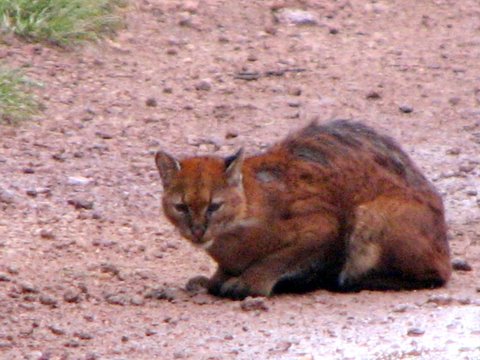|
 This study determined the occurrence, distribution, population status
and food habits of carnivores, and investigated the human factors likely
to affect their survival. Seven sites were selected for in-forest
assessment, on the basis of altitude, vegetation type, and extent of
forest disturbance. Population status was assessed using both direct
methods (night survey) and indirect methods (scent station visitation
rates), along transects in the forest. Geographical Positioning System
(GPS) locations of sightings and signs of spoors and scats were used to map
the distribution of carnivores. Food habits were assessed from scat
analysis. This study determined the occurrence, distribution, population status
and food habits of carnivores, and investigated the human factors likely
to affect their survival. Seven sites were selected for in-forest
assessment, on the basis of altitude, vegetation type, and extent of
forest disturbance. Population status was assessed using both direct
methods (night survey) and indirect methods (scent station visitation
rates), along transects in the forest. Geographical Positioning System
(GPS) locations of sightings and signs of spoors and scats were used to map
the distribution of carnivores. Food habits were assessed from scat
analysis.
Golden cat, Profelis aurata
In addition, a questionnaire was administered to 107 respondents from
eight parishes neighboring the park to assess anthropogenic factors
likely to affect carnivores’ status.
Sixteen carnivore species were recorded representing 42
percent of all species that occur in Uganda. The Clawless otter,
Aonyx capensis Schinz, Spotted necked otter, Lutra maculicollis
Lichtenstein, Honey badger, Mellivora capensis Schreber, and
African wild cat, Felis sylvestris Schreber were recorded for
Bwindi Impenetrable National Park for the first time.
The results indicate that human disturbance and ground vegetation cover
(GVC) are important factors affecting abundance and distribution of
carnivores. The carnivore species, especially Side-striped jackal,
Canis adustus Sundevall and African civet, Viverra civetta
Schreber that mostly depend on scavenging and crop raiding as
alternative ways of obtaining food items were more common in the
periphery of the park, at sites with high human activity. On the other
hand Golden cat, Profelis aurata Temminck, M. capensis and
A. capensis which are not scavengers were mostly restricted to
sites with minimum human presence. High GVC appeared to attract the
species that are more dependent on rodents as main food items. The
distribution of aquatic carnivores, such as Water mongoose, Atilax
paludinosus G. Cuvier, L. maculicollis and A. capensis
was associated with the presence of swamps and rivers, while Banded
mongoose Mungos mungo Gmelin was restricted to the low altitude
side of the park (northern sector), which has predominantly grassland
vegetation.
Among the carnivore species recorded, there was no completely
specialized feeder. Wild prey items featured most prominently, with
rodents and insects being the most common food items. Canis adustus
and V. civetta had opportunistic feeding habits, complimenting
their diets with village refuse, local food crops and wild fruits, while
the Golden cat, P. aurata was the only carnivore species whose
diet mainly consisted of medium sized herbivores especially duikers.
The local people had substantial knowledge of carnivore species: more
than 80 percent of the carnivores species were known to most of them.
The most important factor determining the attitude of the local
residents towards carnivore conservation appeared to be the perceived
economic loss resulting from livestock/poultry raiding.
Such raiding was reported to be on the increase as a result of the better
protection accorded to wild animals.
The use of, and trade in, skins and other products obtained from
carnivores are currently minimal and mostly limited to medicinal
purposes. Genets were the only culturally revered species in the area.
The status of carnivore species is most insecure outside the park as a
result of habitat loss and persecution. Efforts to change negative
attitude of people residing in sites close to the park periphery will
probably take more time. This could be achieved through
introduction of modern poultry farming methods and conservation education. |


 This study determined the occurrence, distribution, population status
and food habits of carnivores, and investigated the human factors likely
to affect their survival. Seven sites were selected for in-forest
assessment, on the basis of altitude, vegetation type, and extent of
forest disturbance. Population status was assessed using both direct
methods (night survey) and indirect methods (scent station visitation
rates), along transects in the forest. Geographical Positioning System
(GPS) locations of sightings and signs of spoors and scats were used to map
the distribution of carnivores. Food habits were assessed from scat
analysis.
This study determined the occurrence, distribution, population status
and food habits of carnivores, and investigated the human factors likely
to affect their survival. Seven sites were selected for in-forest
assessment, on the basis of altitude, vegetation type, and extent of
forest disturbance. Population status was assessed using both direct
methods (night survey) and indirect methods (scent station visitation
rates), along transects in the forest. Geographical Positioning System
(GPS) locations of sightings and signs of spoors and scats were used to map
the distribution of carnivores. Food habits were assessed from scat
analysis.